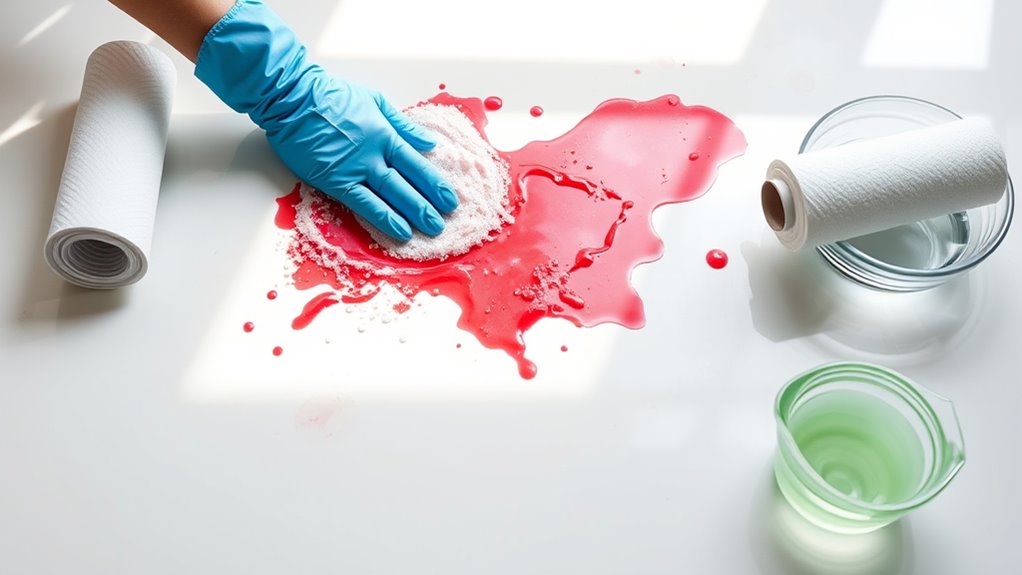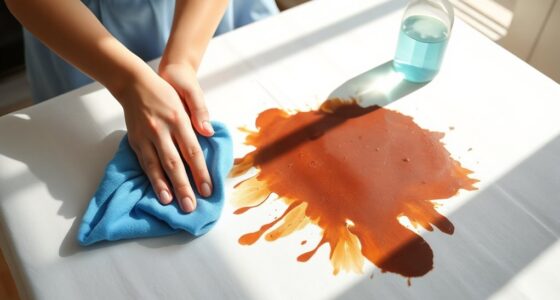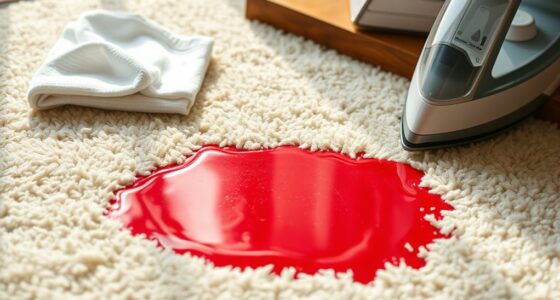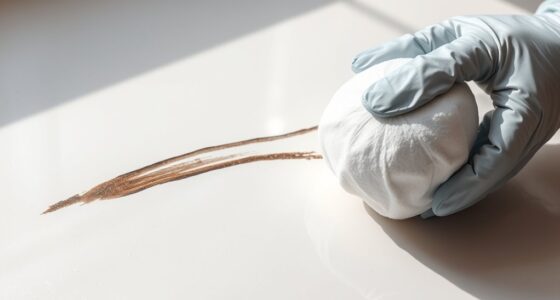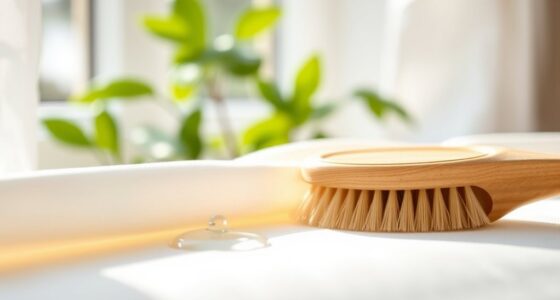To eliminate food coloring stains from your countertops, start by identifying the material. Immediately blot spills with a soft cloth, then clean with warm water and mild dish soap. For tougher stains, create a baking soda paste and let it sit for 10-15 minutes before rinsing. If you have marble, use a baking soda and distilled vinegar paste. Regularly seal natural stone counters and keep cleaning supplies handy for quick action. There’s more to learn about long-term prevention methods.
Key Takeaways
- Blot spills immediately with absorbent materials to contain the stain and prevent it from spreading.
- For tough stains, apply a baking soda paste, let it sit for 10-15 minutes, then rinse thoroughly.
- Use warm water and mild dish soap for gentle cleaning; avoid harsh chemicals on porous surfaces.
- Regularly seal natural stone countertops to prevent staining and clean up spills promptly to minimize stain risk.
- Educate household members on cleanliness and use protective mats during craft projects to catch spills.
Identify Your Countertop Material
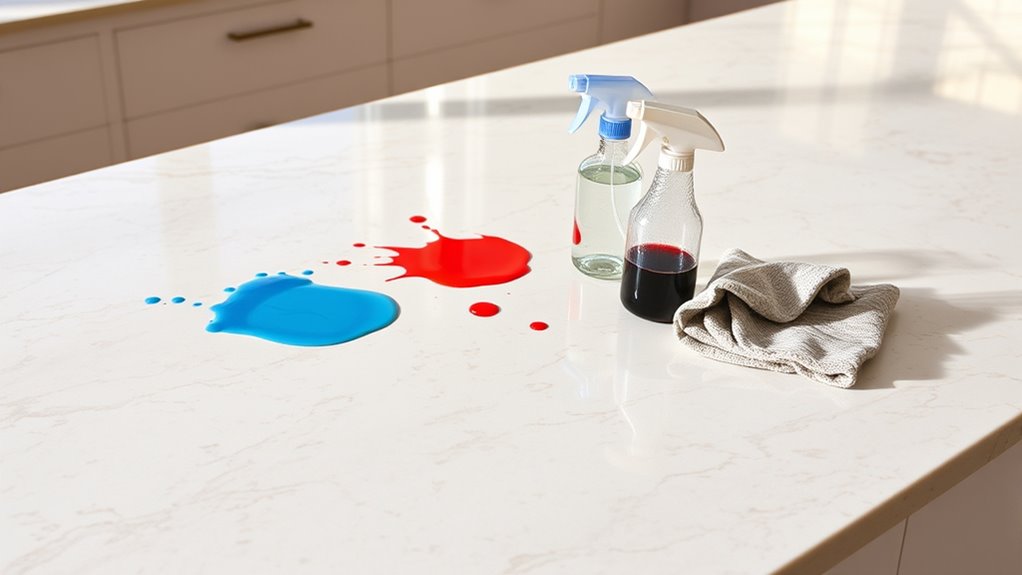
When tackling food coloring stains, the first step is identifying your countertop material. Knowing whether you have granite, marble, quartz, concrete, or soapstone helps determine the best cleaning approach. For instance, granite and marble are porous and require sealing to prevent stains. On the other hand, quartz is non-porous and generally easier to clean. If you have concrete countertops, remember they’re highly customizable but can also stain without proper sealing. Soapstone offers a smooth finish but can absorb food coloring if not maintained. Understanding these characteristics allows you to tailor your cleaning strategy effectively and prevents damage to your surface. Additionally, durability influences long-term value when selecting your countertop material, so take a moment to identify your material before proceeding with any cleaning methods.
Gather Essential Cleaning Supplies
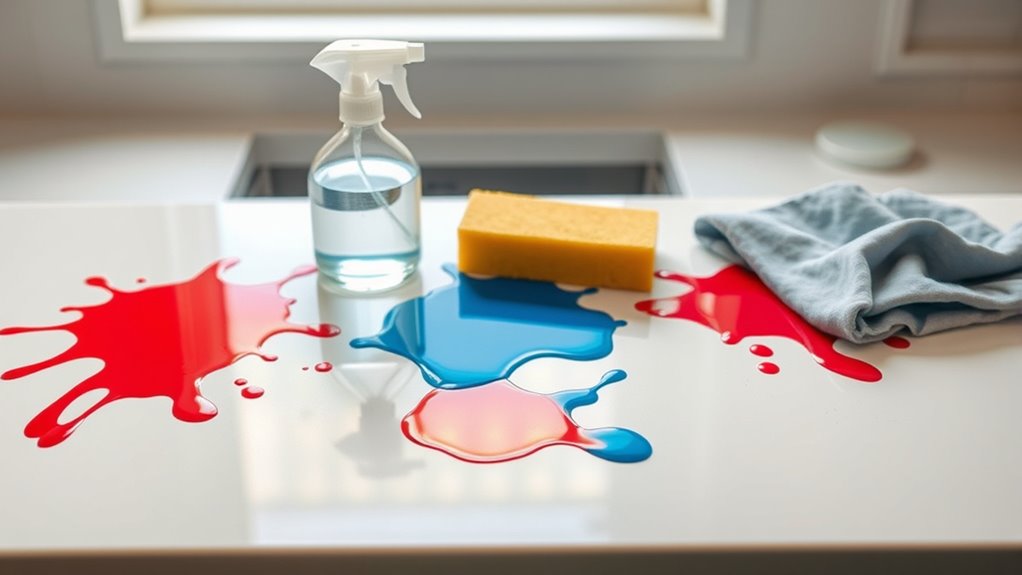
Gathering essential cleaning supplies is crucial for effectively tackling food coloring stains. Start with natural options like baking soda, white vinegar, lemon juice, and mild dish soap. These ingredients are gentle yet potent for initial cleaning. For tougher stains, consider a baking soda and vinegar paste or rubbing alcohol for laminate surfaces. You’ll also need tools like soft cloths, a soft-bristled brush, and a plastic putty knife to help you scrub and scrape away the stains without damaging your countertop. Make a paste with baking soda and water to create an effective stain remover. Additionally, using essential oils for aromatherapy can enhance your cleaning routine with pleasant scents. Don’t forget a spray bottle for easy application and rubber gloves to protect your hands. Always remember to test any cleaning solution on a small, inconspicuous area before applying it broadly.
Immediate Action: Blotting and Cleaning
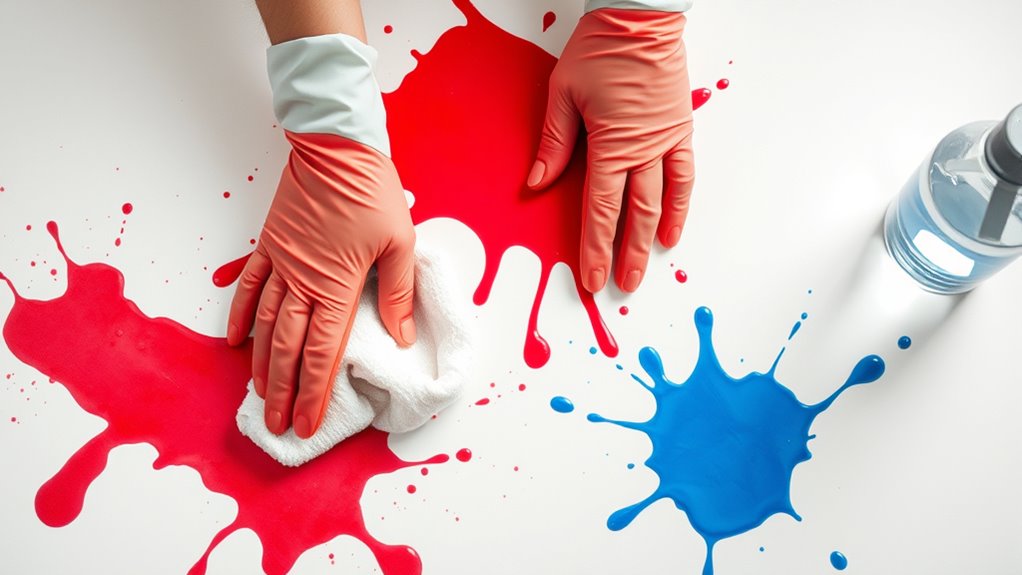
Act quickly to tackle food coloring stains, as immediate action can make all the difference.
Blot the spill right away with absorbent materials like paper towels or soft cloths. Always blot from the outside in to contain the stain and prevent it from spreading. If needed, use damp cloths for fresh stains, applying gentle pressure to absorb the liquid without rubbing.
After blotting, dampen a soft cloth with warm water and add mild dish soap for a gentle clean. For tougher stains, apply a baking soda paste and let it sit for 10-15 minutes. This is important because natural cleaning products are effective without harsh chemicals, which helps to avoid damaging your countertop.
Finally, rinse thoroughly with clean water to remove any residue, ensuring your countertop remains in great condition.
Stain Removal Techniques for Marble Countertops
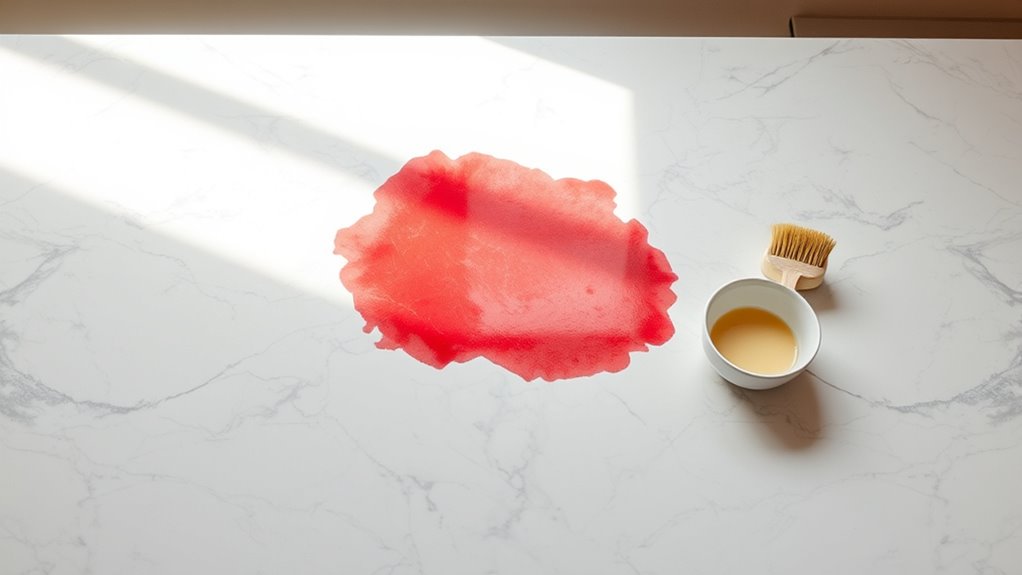
After you’ve tackled immediate food coloring stains, it’s important to focus on effective stain removal techniques specifically for marble countertops.
Address immediate food coloring stains, then prioritize effective stain removal techniques to protect your marble countertops.
Start by testing any cleaning solution in an inconspicuous area. Use warm, distilled water for initial cleaning, avoiding harsh chemicals and acidic substances that could etch the surface.
For natural stain removal, create a paste with baking soda and distilled white vinegar, apply it to the stain, and let it sit for 15 minutes before gently wiping it off with a soft cloth. Natural products are recommended to avoid harsh chemicals that could damage your marble countertop.
For stubborn stains, mix mild dish soap with warm water, scrub gently, and rinse thoroughly.
Always dry the area with a soft cloth to prevent water spots and maintain your marble’s beauty.
Effective Methods for Laminate and Non-Stone Countertops
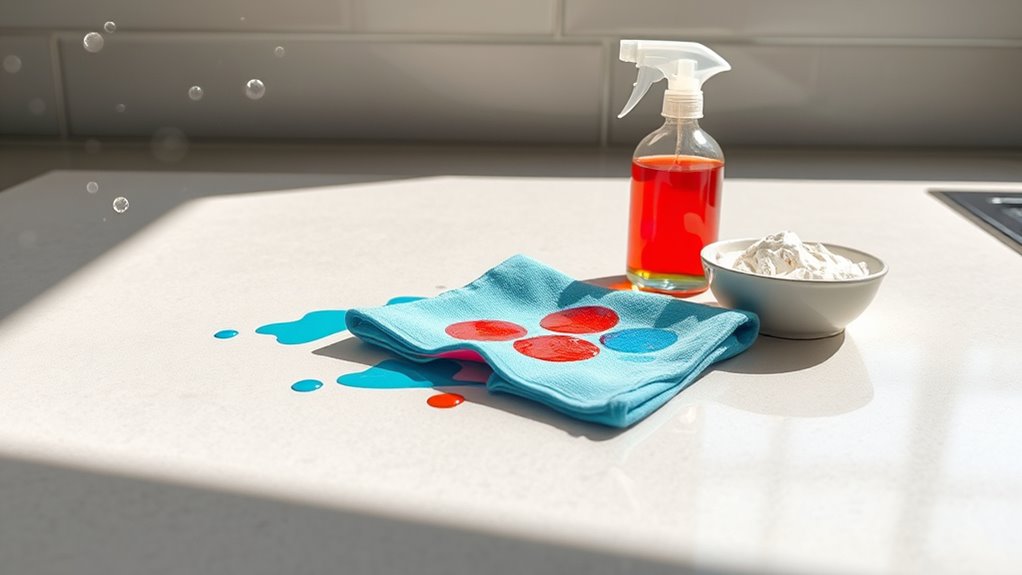
When food coloring stains occur on laminate and non-stone countertops, quick action is essential for effective removal.
Start by using a soft cloth with mild dish soap mixed with warm water to gently scrub the stain. If the stain persists, apply a baking soda paste, let it sit, then scrub and rinse.
For tougher marks, dab rubbing alcohol on a cotton ball and blot the area. Always act fast to prevent stains from setting, as prompt cleaning is crucial to avoid deeper penetration of stains.
To avoid future spills, use protective mats and promptly clean any accidents. Keep cleaning supplies nearby for quick responses, and remember to avoid harsh chemicals that could damage your countertop’s surface.
If stains remain stubborn, don’t hesitate to seek professional help.
Removing Stains From Granite Countertops
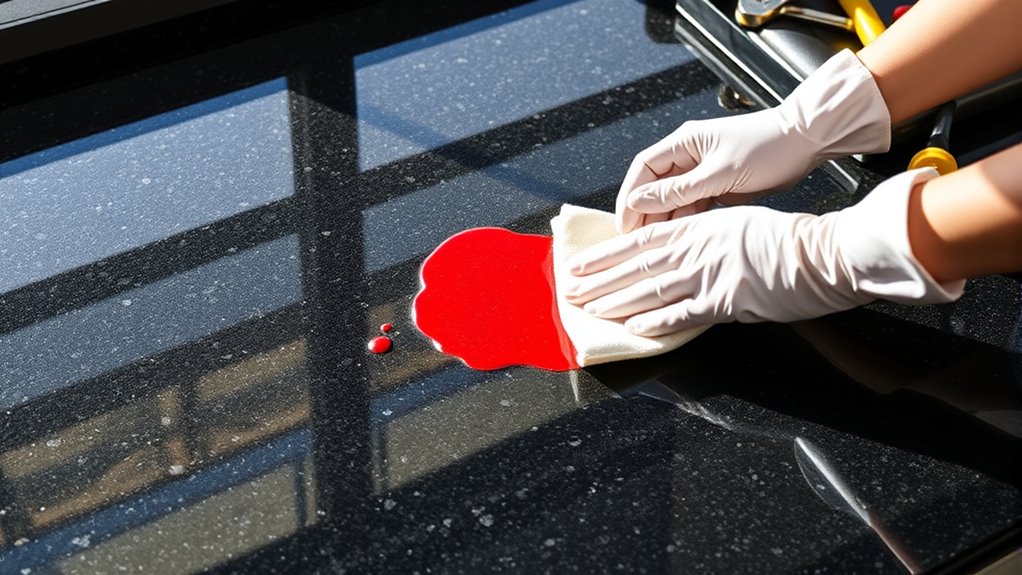
Food coloring stains on granite countertops can be particularly challenging, but quick and proper action can help restore their beauty.
First, blot the stain immediately with paper towels, working from the edges inward to avoid spreading. Avoid harsh chemicals; instead, test mild solutions like warm soapy water or hydrogen peroxide on an inconspicuous area. Effective ventilation can also help maintain the integrity of your countertops by reducing moisture buildup during cleaning.
For persistent stains, create a poultice with talcum powder and acetone, applying it to the stain and covering it with plastic wrap for 48 hours. Afterward, gently scrape off the poultice and rinse. If the stain persists, consider using a new poultice with fresh ingredients. If needed, repeat the process.
Always dry the surface thoroughly after cleaning to prevent water spots. Regular sealing can also prevent future stains from penetrating deeply.
Preventing Future Food Coloring Stains
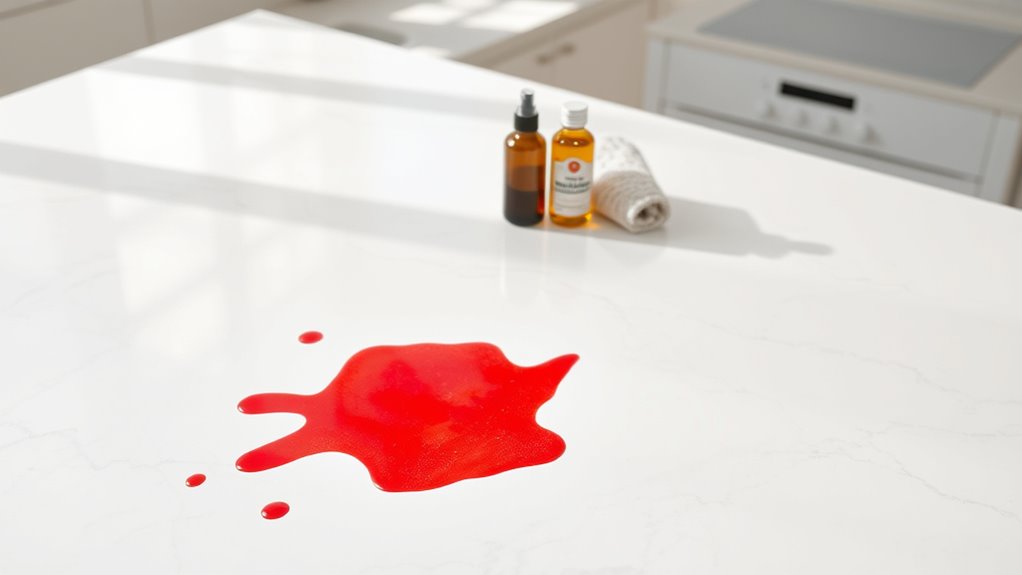
To keep food coloring stains at bay, it’s crucial to take proactive measures in your kitchen.
Start by using protective mats or wax paper under craft projects to catch any spills. Store food coloring in secure containers, away from counter edges, and keep cleaning supplies organized for quick access. Remember that using natural products is more effective for stain removal, so having items like vinegar and baking soda on hand can be beneficial.
Choose stain-resistant countertops and use cutting boards to minimize direct contact. During messy activities, cover surfaces with plastic tablecloths.
Clean up spills immediately, wipe down countertops after each use, and use mild soap and water for daily maintenance.
Remember to seal natural stone countertops periodically and inspect for early signs of stains.
Educate your household on cleanliness to guarantee everyone helps maintain a stain-free environment.
General Tips for Successful Stain Removal
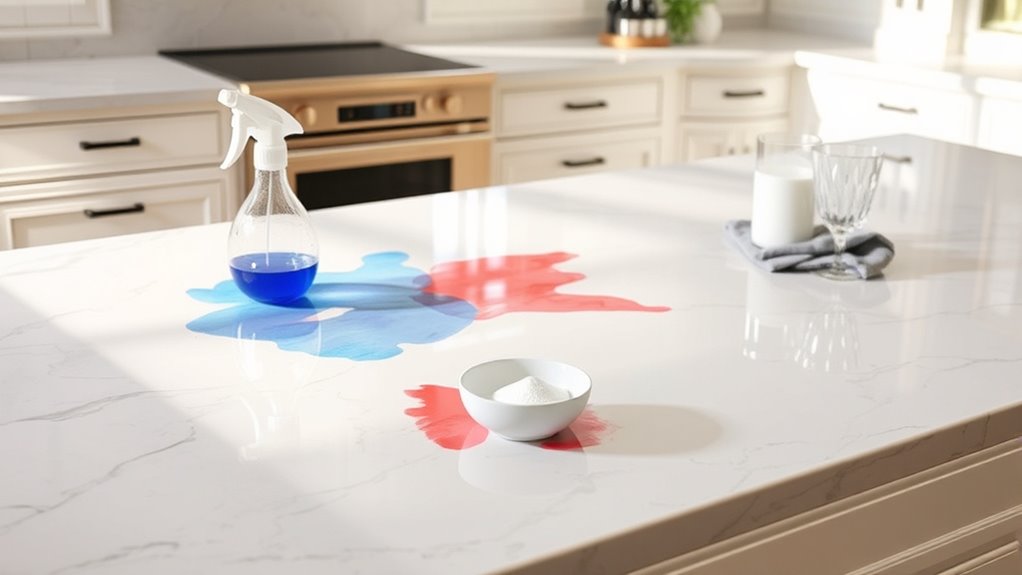
Successful stain removal hinges on understanding the right techniques and agents for each specific stain type. Act quickly when you notice a stain; the sooner you act, the easier it’s to remove. Use gentle physical techniques like brushing or flushing to loosen stains. Always consider your countertop’s material before selecting a cleaning agent. For most food coloring stains, dish soap, baking soda paste, or rubbing alcohol can work wonders. Addressing stains promptly can significantly improve the chances of complete removal. Test any cleaning solution on a small area first to avoid damage. Apply your chosen agent, let it sit, and then gently scrub or wipe away the stain. Regular cleaning habits can help prevent stains from becoming set, making your cleanup process even more effective.
Frequently Asked Questions
Can I Use Bleach to Remove Food Coloring Stains?
You might think about using bleach to tackle food coloring stains, but it’s not always the best choice.
While it can break down pigments, bleach can damage or discolor certain surfaces like marble or laminate. Plus, it may not work effectively on deeper stains.
Instead, consider alternatives like baking soda or hydrogen peroxide, which can be safer for your countertops.
Always test any cleaner on a small area first to avoid unwanted effects.
How Do I Know if the Stain Is Permanent?
You can think of stains as unwelcome guests that linger longer than intended. If you notice a stain stubbornly clinging to the surface after 24 hours, it’s likely made itself at home permanently.
Consider the type of stain and the material it’s on; porous surfaces are more susceptible. If previous cleaning attempts haven’t budged it, you might’ve a permanent resident.
Regular upkeep and swift action can help keep these guests from overstaying their welcome.
What Should I Do if the Stain Spreads?
If you notice a stain spreading, act quickly.
First, isolate the area by covering it with a damp cloth to absorb excess color. Avoid pressing down; instead, gently rub the edges to contain the spread.
Use a suitable cleaning solution like baking soda paste or vinegar, applying it carefully.
Rinse the area thoroughly after cleaning to prevent residue.
Finally, consider applying a sealer to protect against future spills and stains.
Are There Specific Brands of Cleaners Recommended?
When it comes to tackling tough stains, you might feel like a detective on a mission.
For cleaning, brands like Zep and Method offer non-abrasive options that work wonders on various surfaces. If you’ve got natural stone, try StoneCare or Weiman’s pH-neutral cleaners.
For a quick fix, Magic Eraser by Mr. Clean is perfect for non-porous surfaces. Just remember, always check compatibility with your specific countertop material before diving in!
How Often Should I Reseal My Countertops?
You should generally reseal your granite countertops every 12 to 18 months, but if your stone is more porous, consider sealing it every 6 to 12 months.
To check if it needs resealing, perform a simple water test—if water beads up, you’re good; if it absorbs, it’s time to reseal.
Also, keep an eye on wear and tear from spills, as that can affect how often you need to reseal.
Conclusion
In the battle against food coloring stains, think of your countertop as a canvas, waiting for your careful strokes. With the right techniques and quick action, you can restore its beauty, just like an artist reviving a masterpiece. As you wipe away the evidence of culinary creativity, remember that prevention is your best brush. By taking simple precautions, you’ll keep your canvas pristine, ensuring each meal remains a vibrant expression, not a stain-laden memory.
